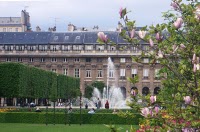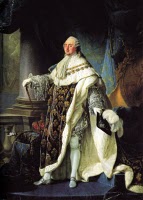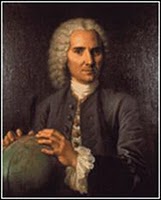Queen Marie Antoinette: Madame Deficit
 Wednesday, July 8, 2009 at 6:26PM Tweet
Wednesday, July 8, 2009 at 6:26PM Tweet Why was Queen Marie Antoinette so reviled by her subjects?
 Marie Antoinette, née Maria Antonia Josepha Johanna von Habsburg-Lothringen, the fifteenth and penultimate child of Francis I, Holy Roman Emperor, and Maria Theresa, Empress of Austria, came to Versailles at the tender age of 14 to marry the 15-year-old Dauphin, or future king, Louis-Auguste, grandson to King Louis XV. The two future monarchs had grown up so pampered that when Louis XV died of smallpox in 1775, just five years after their royal nuptials, even they knew they were not ready for the responsibility before them.
Marie Antoinette, née Maria Antonia Josepha Johanna von Habsburg-Lothringen, the fifteenth and penultimate child of Francis I, Holy Roman Emperor, and Maria Theresa, Empress of Austria, came to Versailles at the tender age of 14 to marry the 15-year-old Dauphin, or future king, Louis-Auguste, grandson to King Louis XV. The two future monarchs had grown up so pampered that when Louis XV died of smallpox in 1775, just five years after their royal nuptials, even they knew they were not ready for the responsibility before them.
 “Dear God,” prayed Louis XVI, falling to his knees, “guide us and protect us. We are too young to reign”.
“Dear God,” prayed Louis XVI, falling to his knees, “guide us and protect us. We are too young to reign”.
As you read here, Louis XVI inherited a France burdened by debt and crippling poverty. He was unprepared to cope with the looming crisis that faced his country. Marie Antoinette was not permitted a political role, nor did she want one. As Queen of France, she had one main job: to produce a male heir.
 Yet the King was as adept in the bedroom as he was on the throne. Seven years passed before he and Marie Antoinette produced a child, and 11 long years before the Queen gave birth to a boy, the first Dauphin, Louis Joseph, in 1781.
Yet the King was as adept in the bedroom as he was on the throne. Seven years passed before he and Marie Antoinette produced a child, and 11 long years before the Queen gave birth to a boy, the first Dauphin, Louis Joseph, in 1781.
In the meantime, Marie Antoinette became the target of libel and gossip, both in and outside Court. Her interests during these years included fashion, gambling, opera, the staging of plays in which she often played a role, and the creation of a vast private pleasure garden at the Petit Trianon. These pastimes were costly at a time when French peasants were surviving largely on bread.
The Queen made things worse for herself by alienating important members at Court when she retreated to the Petit Trianon and refused to invite them for visits!
 Simultaneously, the King saw an opportunity to get back at Britain for his grandfather’s humiliating loss in the Seven Years War. He agreed to send troops and aid totaling 2,000 million livres to support the American revolutionaries. In the 1770s this sum could have fed and housed 7 million French citizens for a year. With France already teetering on financial collapse, this expenditure was seen by many as irresponsible. Indeed, it would have a calamitous effect on the French economy.
Simultaneously, the King saw an opportunity to get back at Britain for his grandfather’s humiliating loss in the Seven Years War. He agreed to send troops and aid totaling 2,000 million livres to support the American revolutionaries. In the 1770s this sum could have fed and housed 7 million French citizens for a year. With France already teetering on financial collapse, this expenditure was seen by many as irresponsible. Indeed, it would have a calamitous effect on the French economy.
Yet, it was the Queen who was blamed. The people dubbed her, “Madame Deficit”. Though she had given her adopted country four children, including two potential heirs to the throne, she would never live down in the eyes of her subjects the reputation that tainted her from her early years at Versailles.
Things went from bad to worse for the Queen during the Diamond Necklace Affair. More on that tomorrow.
Images:
Painting of 12 year old Marie Antoinette, courtesy of Wikimedia Commons.Painting of the new King of France, Louis XVI, 1775, courtesy of Wikimedia Commons.
Painting of Marie Antoinette with her eldest children, Madame Royal and the Dauphin, Louis Joseph, courtesy of Wikimedia Commons.
The Petit Trianon of Versailles by Colocho, courtesy of Wikimedia Commons.
Sources:
Fraser, Antonia. Marie Antoinette: The Journey. London: Phoenix Paperbacks, 2001.
The French Revolution. The History Channel, 2008.
Towle, Sarah B. Time Traveler Tours: Beware Madame La Guillotine. In progress.
 Post a Comment | |
Post a Comment | |  Email Article |
Email Article |  Print Article | tagged
Print Article | tagged  French Revolution,
French Revolution,  Louis XVI,
Louis XVI,  Marie-Antoinette,
Marie-Antoinette,  Petit Trianon |
Petit Trianon |  Permalink
Permalink 













 They did this in the king’s own indoor tennis court where they were forced to convene after the king kicked them out of his meeting. And they swore, in the
They did this in the king’s own indoor tennis court where they were forced to convene after the king kicked them out of his meeting. And they swore, in the  On the south side of the river
On the south side of the river 

 Bonaparte’s was a star that rose fast and fell far. He created important institutions that still survive today, but he also contributed to the violence and upheaval of a century marked by revolution, famine, and war.
Bonaparte’s was a star that rose fast and fell far. He created important institutions that still survive today, but he also contributed to the violence and upheaval of a century marked by revolution, famine, and war.




 Mother-of-the-Uber-Mensch (MUM) and her darling little sis (DLS) were in Paris. They’d flown in to see the Lucky-one-and-only (Loo) in the school play. Loo was in rehearsal. The Uber-Mensch (U-M) was working. So I headed out with MUM and DLS to see the exhibit commemorating the
Mother-of-the-Uber-Mensch (MUM) and her darling little sis (DLS) were in Paris. They’d flown in to see the Lucky-one-and-only (Loo) in the school play. Loo was in rehearsal. The Uber-Mensch (U-M) was working. So I headed out with MUM and DLS to see the exhibit commemorating the 





